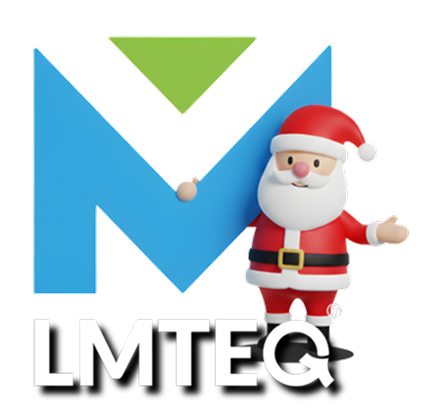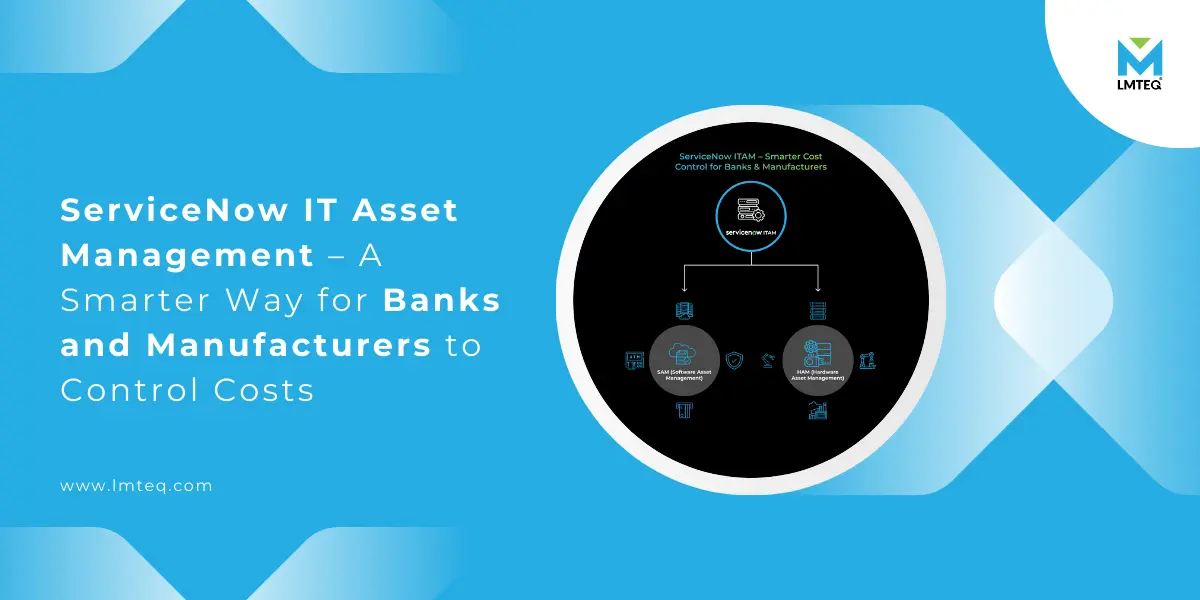Have you ever wondered how much money enterprises lose each year simply because they cannot track their IT assets properly? The numbers are staggering. Around the world, banks overspend by nearly 20–30% on unused or duplicate software licenses, while manufacturers lose up to $1.4 million per plant annually due to unplanned downtime from unmanaged hardware. These inefficiencies don’t just drain budgets—they slow down operations and put organizations at risk of compliance penalties.
This is where ServiceNow IT Asset Management (ITAM) makes a real difference. By combining ServiceNow SAM (Software Asset Management) and ServiceNow HAM (Hardware Asset Management), enterprises gain a single platform to track, control, and optimize every IT asset. For CIOs and IT directors in banking and manufacturing, it’s not just about visibility—it’s about cutting waste, improving compliance, and building smarter IT systems that support business growth.
Table of Contents
- What is ServiceNow IT Asset Management?
- Challenges in IT Asset Management for Banking and Manufacturing
- How ServiceNow SAM and HAM Solve These Problems
- IT Asset Lifecycle Management with ServiceNow – Step by Step
- ServiceNow ITAM in Action – Industry Use Cases
- The Business Value – Optimize IT Costs with ServiceNow
- Why Enterprises Trust ServiceNow for ITAM
- FAQs
- Conclusion
What is ServiceNow IT Asset Management?
ServiceNow IT Asset Management is a single platform that helps enterprises track and control both software and hardware assets throughout their lifecycle. It is made up of two key modules :-
- ServiceNow SAM (Software Asset Management) – Helps CIOs and IT teams manage licenses, track usage, and ensure compliance with vendor agreements.
- ServiceNow HAM (Hardware Asset Management) – Monitors laptops, desktops, servers, and even specialized hardware across their entire lifecycle, from purchase to retirement.
Think of it like a central nervous system for all your IT assets. Whether you’re running a bank with 10,000 laptops or a manufacturing plant with 2,500 servers, ITAM ensures nothing goes unnoticed or unused.
Challenges in IT Asset Management for Banking and Manufacturing
For Banks (BFSI)
- Software audits that expose over-licensing or unauthorized use.
- Complex infrastructure spanning ATMs, data centers, cloud apps, and desktops.
- Cost optimization pressure, as IT budgets face tighter scrutiny from regulators and boards.
For Manufacturing
Manufacturers manage vast distributed environments across plants and warehouses. CIOs here often struggle with :-
- Legacy and modern hardware mix, including sensors, servers, and production systems.
- Seasonal workforce needs require quick scaling of licenses without waste.
- Unplanned downtime costs up to $260,000 per hour in large factories when systems fail.
Both industries share the same issue: without structured IT asset visibility, the risks of overspending, downtime, and compliance failures grow rapidly.
How ServiceNow SAM and HAM Solve These Problems
ServiceNow SAM (Software Asset Management)
- Tracks all active software licenses in one place.
- Prevents overspending by reclaiming unused licenses.
- Reduces audit risks by keeping compliance records always up-to-date.
ServiceNow HAM (Hardware Asset Management)
- Provides full visibility into all hardware assets.
- Automates lifecycle tracking: from procurement, warranty, maintenance, to disposal.
- RPrevents “ghost assets” — hardware that is purchased but not in actual use.
Together, SAM and HAM also enhance ServiceNow compliance management. For example, a bank facing a vendor audit can generate a ready-to-share compliance report in minutes instead of weeks. Similarly, a manufacturer can quickly identify which servers are nearing warranty expiry and take proactive action.
IT Asset Lifecycle Management with ServiceNow – Step by Step
ServiceNow IT Asset Management follows a simple but powerful lifecycle model that enterprises can apply across banking and manufacturing :-
- Procurement – Assets are purchased and automatically recorded in ServiceNow.
- Deployment – Hardware and software are assigned to users or departments.
- Usage – Continuous monitoring tracks actual usage and performance.
- Maintenance – Automatic alerts for renewals, patching, or warranty services.
- Retirement – Assets are properly decommissioned or recycled, ensuring compliance.
For example, in ServiceNow for banking ITAM, unused licenses from inactive employees can be reclaimed and reassigned. In ServiceNow for manufacturing ITAM, hardware used in production lines can be tracked for predictive maintenance, reducing downtime.
This lifecycle approach ensures true IT asset lifecycle management with ServiceNow, giving CIOs peace of mind and clear control.
ServiceNow ITAM in Action – Industry Use Cases
| Industry | Common Challenge | How ServiceNow ITAM Helps | Projected Benefits |
|---|---|---|---|
| Banking (BFSI) | Software audits expose overspending and compliance gaps. | ServiceNow SAM automatically tracks licenses, reclaims unused ones, and keeps audit-ready records. | Up to 30–40% license cost savings and 50% less audit prep time. |
| Managing thousands of ATMs, servers, and desktops across branches | ServiceNow HAM gives real-time visibility of all hardware, with lifecycle tracking. | 25% faster refresh cycles and reduced ghost assets. | |
| Vendor lock-in creates high renewal costs with little negotiation power. | License optimization reports give CIOs leverage during renewals. | 15–20% reduction in renewal costs. | |
| Lack of centralized dashboards for executives. | Role-based dashboards in ServiceNow ITAM provide real-time insights for IT Directors and CIOs. | Faster decision-making and reduced reporting overhead. | |
| Manufacturing | Frequent downtime in production systems due to unmanaged hardware. | Predictive maintenance alerts through ServiceNow HAM, tied to the asset lifecycle. | Prevents losses of up to $260,000/hour from downtime. |
| Seasonal workforce creates license scaling challenges. | ServiceNow SAM enables flexible allocation and reclamation of software licenses. | Cuts 20–25% of wasted license spend during seasonal peaks. | |
| Multiple plants with fragmented asset visibility. | Unified ITAM dashboards show all plant-level assets in a single view. | Improves asset utilization by 30%. | |
| Delays in retiring outdated machines lead to higher maintenance costs. | Automated retirement workflows ensure timely decommissioning. | 20% savings in annual maintenance costs. |
The Business Value – Optimize IT Costs with ServiceNow
The financial impact of ITAM cannot be overstated. Organizations that have implemented ServiceNow ITAM report :-
- 30–40% reduction in software licensing costs in the first year.
- 25% faster hardware refresh cycles, leading to better productivity.
- 50% reduction in audit preparation time for BFSI firms.
For banks, this means fewer compliance penalties and leaner IT budgets. For manufacturers, this means less downtime and smoother production cycles. Put simply, CIOs can directly optimize IT costs with ServiceNow while maintaining enterprise-wide compliance.
Why Enterprises Trust ServiceNow for ITAM
ServiceNow is trusted worldwide because it is not just an ITAM tool—it is part of a larger platform that integrates IT Service Management (ITSM), IT Operations Management (ITOM), and even Governance, Risk, and Compliance (GRC). This integration allows :-
- Role-based dashboards for CIOs and IT directors to see ITAM performance at a glance.
- Cross-module insights, such as linking asset failures with incident management.
- Scalability, so ITAM can grow as the enterprise grows.
Banks trust ServiceNow because it keeps them audit-ready at all times. Manufacturers rely on it to manage the complexity of hybrid IT and operational technology environments. The platform gives decision-makers confidence that their IT investments are being maximized.
Also Reads :-
FAQs
1. What is the difference between ServiceNow SAM and HAM?
SAM focuses on managing software licenses, compliance, and usage optimization, while HAM tracks physical hardware throughout its lifecycle, from purchase to retirement. Together, they form a complete IT asset management solution.
2. How does ServiceNow ITAM help banks and manufacturers reduce costs?
Banks save money by reclaiming unused licenses and avoiding compliance fines. Manufacturers cut costs by reducing downtime with proactive hardware tracking and predictive maintenance.
3. What is IT asset lifecycle management with ServiceNow?
It is the process of tracking an asset from purchase to retirement. With ServiceNow, this includes procurement, deployment, usage, maintenance, and retirement—all automated for better control and compliance.
Conclusion
In industries like banking and manufacturing, where compliance, efficiency, and cost control are non-negotiable, ServiceNow IT Asset Management offers a clear path forward. By combining the power of ServiceNow SAM (Software Asset Management) and ServiceNow HAM (Hardware Asset Management), enterprises gain visibility, reduce risks, and cut costs.
If you are a CIO or IT leader looking to gain full visibility and reduce IT costs, explore how ServiceNow IT Asset Management can help your enterprise move smarter.

